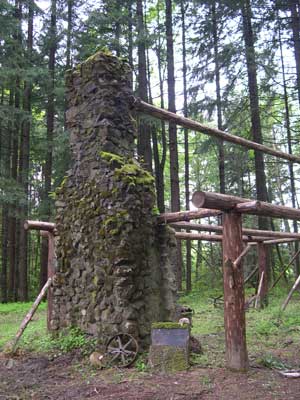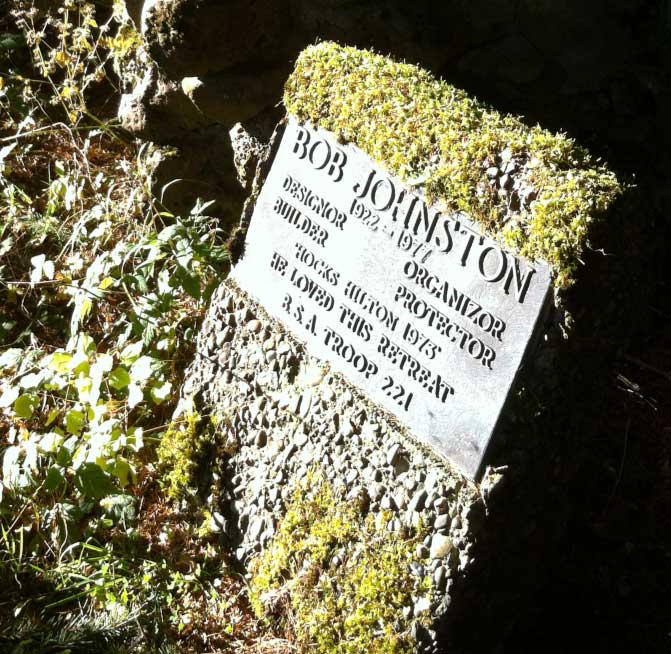Here is is an excerpt from a piece I just completed and added to the roster of trails listed under the geographic tab for the West Hills. In this “historic trail” description I try to use nuggets of contemporary opinion about the Jason Lee Route to “Hillsborough”, my own knowledge of the landscape, some old maps and the wonderful recollections captured in the locally published, Dixie Mountain Legacies. It was through this source that I first learned the real history of the Sophie Mozee place.
…No more than a half mile onwards you will emerge onto a level area, and on your right inside a copse of older Douglas Fir trees you can see the chimney of an old ruined cabin. Humble as it may seem to day, this place has history!
Standing next to the cabin you can look out from the trees that surround the cabin site and see a small valley that is no doubt heavily populated with deer every evening and dawn. To your left, looking eastwards is a magnificent view of the Pacific Northwest skyline. Lined up like white capped sentinels you can count off the snowy peaks from Mt. Baker to the north, to Mt. St. Helens and Mt. Adams to the East. Just out of sight around the end of Rocky Point is, of course, Mt. Hood.
Near the ruined log cabin, a plaque stands embedded in a concrete block. It commemorates Bob Johnstone, whose age would make him a late WWII vet or a participant in the Korean conflict if he served in the armed forces. He was just 55 when he died – maybe one of those whose lives were shortened by a lifelong habit of smoking Chesterfields and Marlboro’s? Were he alive today to tell us about the cabin, he would be a frail 91 years old. But in any case “Hock” as he seems to have been called loved this place he called his “Hilton” and his Boy Scout Troop 221. Looking about one it is easy to understand why Bob “loved this retreat”.
 I have not been able to discover more about Bob Johnston, but one can almost feel the presence of an unseen caretaker, even as the Sword Ferns and Oregon Grape reconquer their space in the quiet that has reclaimed this beautiful spot. I can certainly appreciate his love for this remote cabin. I believe that during the time of his involvement with the cabin, it was fully functional, and later burned down under mysterious circumstances. If there are those out there that know more about this location and its benefactors, please contact me so that I can fill in the details, beyond what we know from the plaque.
I have not been able to discover more about Bob Johnston, but one can almost feel the presence of an unseen caretaker, even as the Sword Ferns and Oregon Grape reconquer their space in the quiet that has reclaimed this beautiful spot. I can certainly appreciate his love for this remote cabin. I believe that during the time of his involvement with the cabin, it was fully functional, and later burned down under mysterious circumstances. If there are those out there that know more about this location and its benefactors, please contact me so that I can fill in the details, beyond what we know from the plaque.
But this place has a deeper and older significance – one that befits a dramatic retelling around the Boy Scout campfire. You see, originally this place was the homestead of Sophie Mozee, but like many of the original pioneers she seems to have cashed in her land leaving behind only her name tied to a tidy little valley on the side of Dixie Mountain. It appears the location was not that convenient and the place stood empty for a while. But around the end of 1893 and into the wintry months of 1894, it seemed that quite a number of homes were being burglarized, but no one knew who was doing this. But one day a settler homesteading the tract of land next to the Sophie Mozee plot was surprised to find a stranger eating his dinner, after he had gone out to get some fresh water from the spring. Seeing the man was heavily armed, he opted for geniality and the man finished the meal and slipped off into the woods. Later efforts to track the culprit(s) divulged little except that they often hiked out to Scappoose. But in August came the proverbial, “lucky break” in the case. The chief burglar’s mate had a falling out with his associate and he quickly volunteered all he knew to the St. Helen’s police. According to the informant the chief burglar was an escaped convict called John Bain and he was determined not to be taken without a fight. Constable Ed Fowler was soon dispatched to Dixie Mountain and as they were riding up Rocky Point Road they actually rode past Bain, who was on foot and armed with a rifle. It took some persuading, but eventually Constable Fowler was able to round up a posse of six settlers to help him apprehend the villain. At midnight the six slipped out of their homes and made their way silently down Rocky Point Road and along the track that led to the Mozee place. There they took up positions all around the cabin hoping to surprise Bain when he came out to wash in the early morning.
But morning came with its damp breezes chilling the men as they stood silently waiting. All remained still, but still no one emerged from the cabin, though one of the posse thought he spied movement within. The sun began to rise and still nothing happened. But just then one of the posse, Abe Nelson, happened to look back at the forest behind them and saw John Bain emerging from the forest with a sack over his back. Bain saw him and the constable and defiantly told them that they “better get out damn quick!” With the posse lining up opposite Bain, the Constable quickly rose and pointing his revolver at the alleged burglar and demanded him to “throw up your hands!” To this Bain replied, “No! Go to hell!”.
Reportedly he stood looking at the posse for a moment longer, sizing up his chances with this rag-tag brigade of farmers. Suddenly he leaned over, dropped the bag and produced a revolver and starting shooting. Jumping around wildly to avoid being hit Bain emptied his revolver at the posse and then sprinted for the woods when he ran out of bullets. Abe Nelson, who had first spotted Bain, now drew careful aim at the vanishing figure and got off one more shot as he vanished into the woods. It was this final shot that was thought to have brought him down. But at the Constable’s advice they decided not to give chase, but instead seek out the figure they thought they’d seen inside the cabin.
Battering down the door, the group now searched the cabin, but found no one inside. A few days later Bain’s friends came looking for him, only to find him lying dead just outside the clearing at the cabin. Though mortally wounded he had retrieved a shotgun from a hidden stash and had been lying in wait when he finally died. Bain it seems was seriously determined not to be captured and he had good reasons for this.
As a teenager Bain had been convicted of killing a Chinese-American with an meat axe while employed in a butcher shop. He served out his time, but shortly after being released he killed both his children. He was convicted again, but this time he escaped after serving only a short time and had been leading a lawless existence ever since. And so it seemed the story came to an end. But there was still that loose end about the figure seen through the window – what had happened to that mysterious figure?
Many years later, one of the Dixie Mountain kids, Robert Service Jr. was working on a logging crew cutting wood around Rocky Point Road. It was the custom then to pass the cold nights in the bunkhouse telling stories and swapping yarns, there being precious little else they could do in that pre-electrification era. One of the loggers, William Gentry, then volunteered a story of how he’s been invited to go deer hunting by a fellow passenger on a Scappoose-bound riverboat. Climbing up to his cabin, they had supped on venison and shared a double bunk. But in the morning, William had awoken to an empty bed and an absent host. being hungry he was about to fix himself breakfast when all hell broke loose outside with gunfire resounding all around the solitary valley. Seeing no chance of escape out the door, William locked the door from the inside and pried a board from the boarded up chimney. Slipping inside he replaced the panel and climbed up into the chimney bench, where he sat silently through all the ensuing search. After everyone finally left he quickly exited the cabin and ran all the way down the hill. Never had he been so scared, he admitted to his bunkhouse mates.
Nor did this spell the end of dubious goings on on the Sophie Mozee spread. During the prohibition from 1916 to 1933 moon-shining became a rather profitable business in these remote canyons and obscure clearings in the dense forest. While it is said that many were profitably engaged in the production of illicit drink, there were also considerable incursion made by the local police. Clarence Nelson, a relative of Abe Nelson who got off the final shot during the melee at the Mozee place, discovered a still operating at a spring not far removed from the old cabin. He decided to take his eldest daughter and son down to see what moon-shining was all about. But upon approaching the site they were surprised by an old woman brandishing a six-shooter which cut short their education as they raced for safety at the top of the hill. It is said that there still remain many old remnants of these illegal stills buried deep in the ravines below Dixie Mountain – as well as along the entire Eastern face of the Tualatin Hills from Burlington to St.Helens and beyond.

Do you know who owns this property? Im interested in contacting them for filming permission